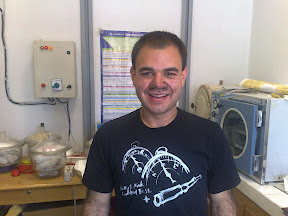I don't know if any of you noticed, but I haven't posted once about the research that I am doing. I have been thinking about it for a while, but there was always something far more fun to post about. So, I figure that it's about time to at least mention what I'm doing. As most, if not all, of you know, I work with carbon and glass fiber composite structures. More specifically, I use various methods (ultrasonic waves, electrical resistance, etc) to detect damage to these structures. My work here involves using electrical resistance to detect damage caused by objects impacting a composite panel. Previous attempts have just used the conductivity of the carbon fiber to detect this damage, but I decided to also incorporate the abilities of the group here at METU to also make the plastic matrix (the part that holds the fiber weave together) conductive to increase the resolution and resistivity change before and after impact. Also, making the plastic resistivity will also cause it to be around the percolation threshold, which means that the plastic is just barely conductive, making the resistivity very sensitive to any stretching of the plastic. Measuring this resistivity change, one can determine how much a airplane wing is experiencing during flight.
Right now there are two methods that involve carbon to make plastics conductive. The first being Carbon Black which is basically soot. Carbon Black is created by a variety of means, one of which is scraping the soot out of particular furnaces. The other method uses Carbon Nanotubes. These little guys have been hot stuff for the past 10 years or so. They were supposed to be the answer to creating the space elevator and a few other extravagant ideas.
Well, I started making Carbon Black (CB) and Polypropylene blends and measuring their conductivity. Well, working with CB is very messy as it sticks to everything. They have used surgical masks in the past to keep from breathing it in, but I found out that they don't work. (See picture...) After creating the blends, I was told that the CB I was using was of a far lesser quality than the one they used in their journal paper a few years ago. So, I will be starting with Carbon Nanotubes this next week. The ultimate goal is to train an Artificial Neural Network (ANN) how to determine the size and location of impact damage only using a series to resistivity measurements inside a sample. An ANN works on the principle of how we and other animals learn which is based on neuron transport and so forth. If anyone is interested you can read about it at Wikipedia. With any luck, I'll be able to create a conductive polymer carbon fiber composite by the end of the summer that is able to be used to detect damage with in it.
One great benefit is that the conductive matrix also makes the composite conductive enough that it should act as a Faraday cage. This is how aircraft (and cars) are protected at the moment from lightning strikes. When the lightning strikes, the electrons within the material move to cancel out the change in voltage causing the electric field within the structure to be zero, protecting the electrical instruments, aircraft structures, and the passengers inside. Present carbon and glass fiber structures in aircraft have copper meshes incorporated in them to act as the Faraday cage. This mesh would be replaced, save precious weight on the aircraft.
By conducting this summer research, it will be give me some new techniques to use on my thesis research. This work has also given me a clearer path on which thesis topic to pick. So far, it has been a good research experience.
Saturday, July 26, 2008
Subscribe to:
Post Comments (Atom)

3 comments:
Oh my beautiful son! Wipe your nose honey. haha My God you've become positively skinny!
Yeah, I have had to make two smaller notches on my belt...
ok. semms to be good work. Im workng with carbon nanotube rubber composites and carry out some conductivity studies too .Can you plz mention which instrument you use to measure the conductivity of composites. and how you do the calculation(plz specify the sample size and appearance). If u can give reply ..would be a grt help
Post a Comment